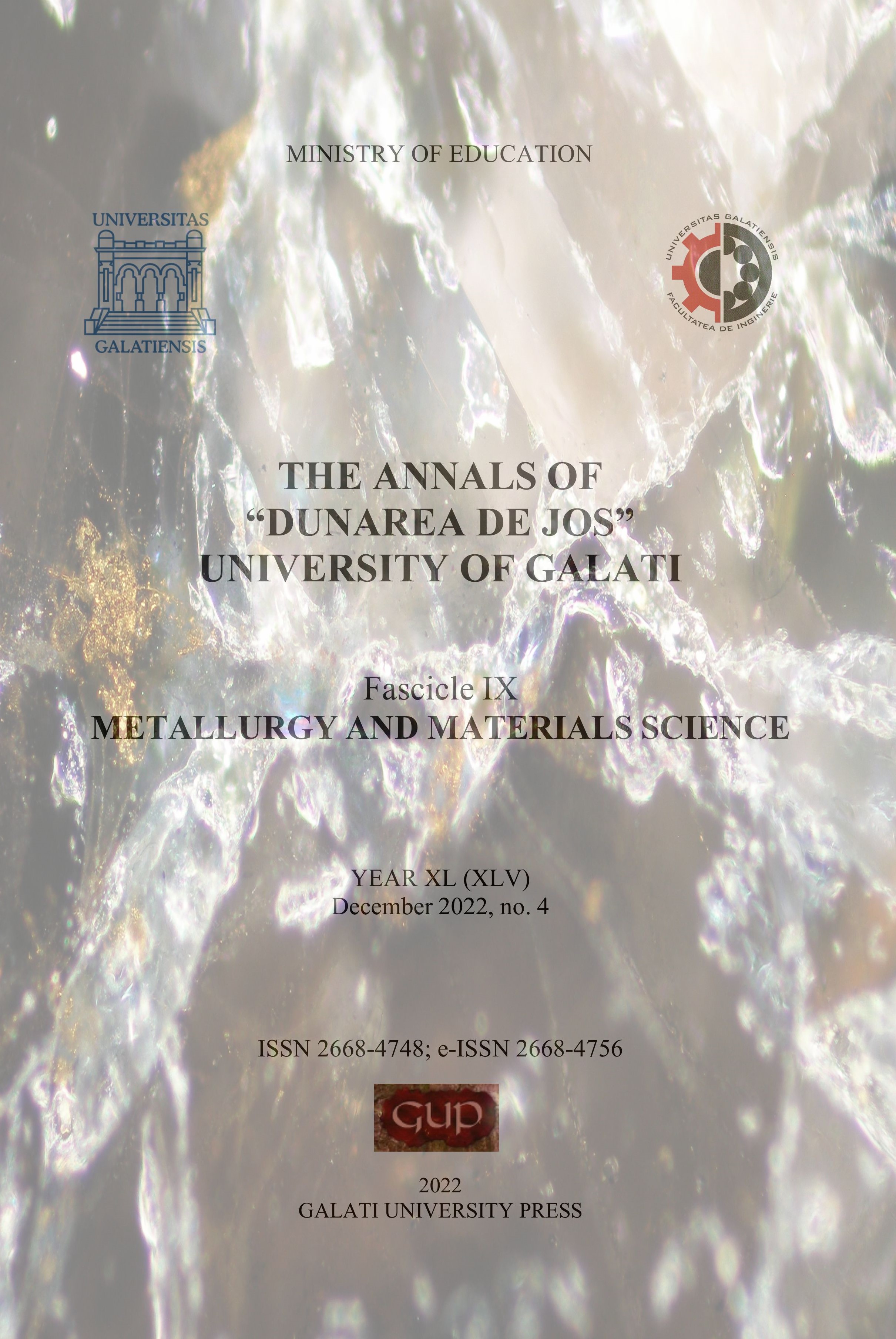Dielectric PMMA Thin Layers Obtained by Spin Coating for Electronic Applications
Abstract
Thin polymeric films with dielectric properties become a very important part of today’s devices, being indispensable in industry, electrical applications and not only. Nowadays polymeric materials have attracted attention in academic and industrial research due to the miniaturization at the micro and nanoscale of different electronic devices. Polymers in general are used for their light weight, good mechanical strength, dielectric properties, and optical properties, which make them multifunctional materials.
This paper presents research on polymethyl methacrylate (PMMA) thin films obtained by the sol-gel method. The optimization of thin film PMMA layers has been a problem due to the importance of using the polymer in the different electronic domains. Thin films of PMMA with different thicknesses were deposited onto glass and silicon wafers in order to measure dielectric properties. For dielectric properties, the PMMA thin layer was inserted in a metal-insulator-metal structure (MIM). In order to observe the morphology and roughness of thin film, optical microscopy, scanning electron microscopy and atomic force microscopy have proceeded.
The dielectric constant (k) was calculated using the electrical capacitance formula. The I-V and C-V curves showed a dielectric behavior with a leakage current between 10-11 and 10-8 A and a constant capacitance in the bias range ± 5 V.
Downloads
References
[2]. Valcu E. E., Musat V., Jank M., Oertel S., Sol-gel preparation of ZrO2-PMMA for thin films transistors, Rev. Chim., vol. 65, no. 5, p. 574-577, 2014.
[3]. Muşat V., et al., Low-Temperature and UV Irradiation Effect on Transformation of Zirconia-MPS nBBs-Based Gels into Hybrid Transparent Dielectric Thin Films, Gels, vol. 8, no. 2, doi: 10.3390/gels8020068, 2022.
[4]. Shekar B. C., Sathish S., Sengoden R., Spin coated nano scale PMMA films for organic thin film transistors, Phys. Procedia, vol. 49, no. 0, p. 145-157, doi: 10.1016/j.phpro.2013.10.021, 2013.
[5]. Tippo T., Thanachayanont C., Muthitamongkol P., Junin C., Hietschold M., Thanachayanont A., The effects of solvents on the properties of ultra-thin poly (methyl methacrylate) films prepared by spin coating, Thin Solid Films, vol. 546, p. 180-184, doi: 10.1016/j.tsf.2013.05.022, 2013.
[6]. Mohajerani E., Farajollahi F., Mahzoon R., Baghery S., Morphological and thickness analysis for PMMA spin coated films, J. Optoelectron. Adv. Mater., vol. 9, no. 12, p. 3901-3906, 2007.
[7]. Syamala Rao M. G., et al., ZrHfO2-PMMA hybrid dielectric layers for high-performance all solution-processed In2O3-based TFTs, Mater. Res. Bull., vol. 150, no. December 2021, doi: 10.1016/j.materresbull.2022.111768, 2022.
[8]. Emanuela E., Herbei V., Musat V., Oertel S., Jank M., High-k dielectric inorganic-organic hybrid thin films for field effect transistors (FETFT), p. 64-68, 2013.
[9]. Schröder S., Strunskus T., Ababii N., Lupan O., Magariu N., Faupel F., New vapor deposited dielectric polymer thin films for electronic applications, p. 94-96, doi: 10.52326/icecco.2021/el.02, 2022.
[10]. Forte M. A., Silva R. M., Tavares C. J., Silva R. F. E., Is poly(Methyl methacrylate) (PMMA) a suitable substrate for ALD?: A review, Polymers, vol. 13, no. 8, doi: 10.3390/polym13081346, 2021.
[11]. Buchheit R., Kuttich B., González-García L., Kraus T., Hybrid Dielectric Films of Inkjet-Printable Core–Shell Nanoparticles, Advanced Materials, vol. 33, no. 41, doi: 10.1002/adma.202103087, 2021.
[12]. Sathish S., Shekar B. C., Dip and spin coated nanoscale transparent PMMA thin films for field effect thin film transistors and optoelectronic devices, J. Optoelectron. Adv. Mater., vol. 15, no. 3-4, p. 139-144, 2013.
[13]. Morales-Acosta M. D., Quevedo-Lopez M. A., Alshareef H. N., Gnade B., Ramirez-Bon R., Dielectric properties of PMMA-SiO2 hybrid films, Mater. Sci. Forum, vol. 644, no. March, p. 25-28, doi: 10.4028/www.scientific.net/MSF.644.25, 2010.
[14]. Herbei E. E., Busila M., Alexandru P., Epure S., Musat V., Dielectric Behaviour of PVP 360 and PVA for Thin Flexible Transistors Application, Mater. Plast., vol. 59, no. 1, p. 1-7, doi: 10.37358/MP.22.1.5554, 2022.
[15]. Pantano M. F., Pavlou C., Pastore Carbone M. G., Galiotis C., Pugno N. M., Speranza G., Highly Deformable, Ultrathin Large-Area Poly(methyl methacrylate) Films, ACS Omega, vol. 6, no. 12, p. 8308-8312, doi: 10.1021/acsomega.1c00016, 2021.
[16]. Aras G., Orhan E., Selçuk A. B., Ocak S. B., Ertuğrul M., Dielectric Properties of Al/Poly (methyl methacrylate) (PMMA)/p-Si Structures at Temperatures Below 300 K, Procedia - Soc. Behav. Sci., vol. 195, p. 1740-1745, doi: 10.1016/j.sbspro.2015.06.295, 2015.



